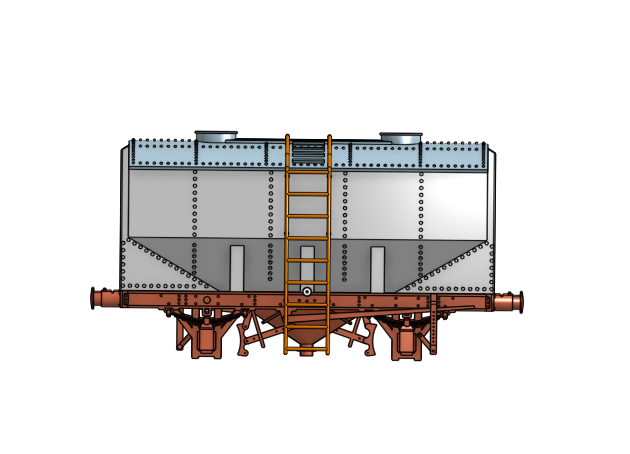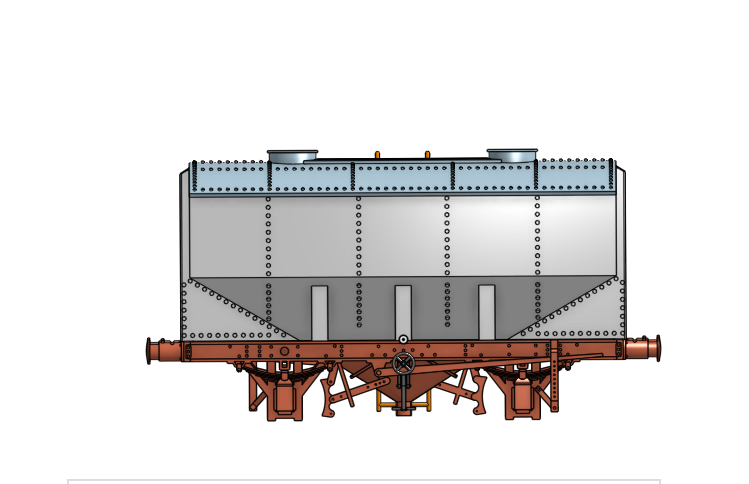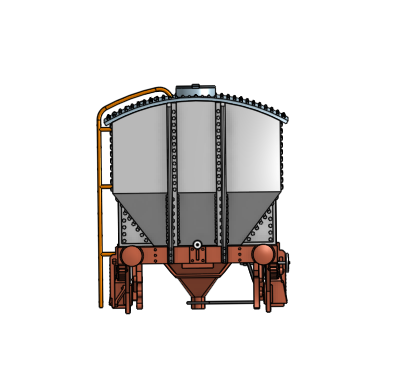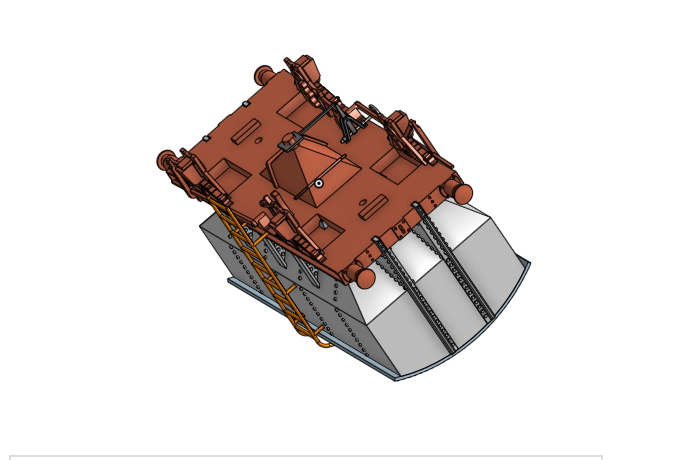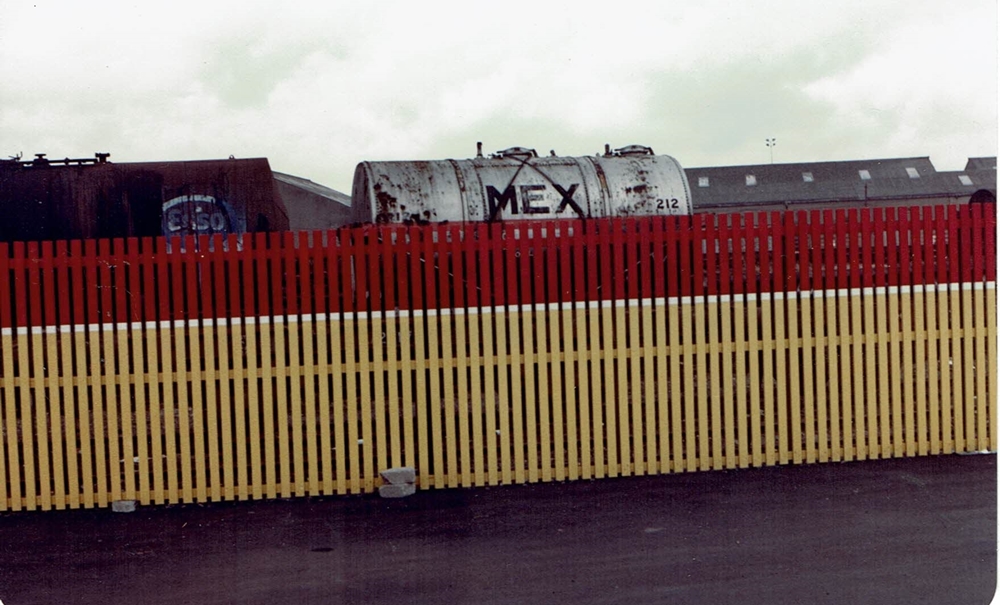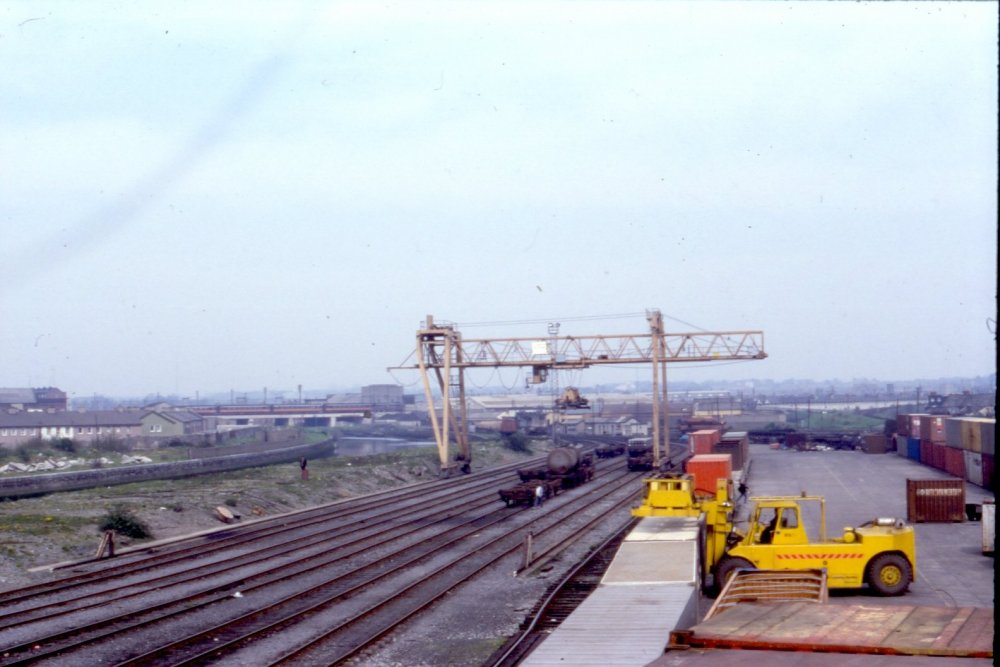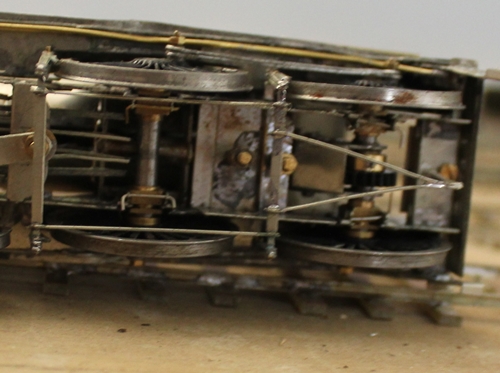-
Posts
4,880 -
Joined
-
Last visited
-
Days Won
119
Content Type
Profiles
Forums
Events
Gallery
Everything posted by Mayner
-
The ESSO Teo Bitumen tank wagons appear to have been re-gauged from ESSO 22T Bitumen wagons built in the late 1950s rather than the 45GLW type like the Bachmann model which would have been too heavy to run in Ireland There is a good selection of photos on ESSO 22T Bitumen Tank Wagons in their original condition in https://paulbartlett.zenfolio.com/essobitumenvb. Many of the UK tanks were re-built with revised running gear and tank mounting. Railborne bitumen traffic to Cold Chon Sligo was a short lived 90s revival, IE discontinued bitumen traffic by individual wagon load during the mid 1970s transporting the traffic in ISO containers with road transfer to distributors such as Cold Chon, Irish Tar and Bitumen and Council Depots. Esso Teo appears to have stored its relatively modern (by Irish standards) 22T Bitumen tankers which appear to have been re-used when the Sligo quayside siding was re-opened during the 1990s. Oranmore was the rail head for Bitumen, Oil and Scrap Metal traffic in the Galway area until the sidings were disconnected in the late 70s, bitumen and scrap transported by Liner Train in ISO containers with a road transfer from Galway, ESSO oil traffic apparently transferring to coastal shipping. Oranmore would have been interesting in wagon load days Chold Chon used a Scammell Road road tractor on rail wheels as a year shunter.
-
Just to confirm that the JM Design CIE 20T goods brake will be produced as a rtr model starting with the 1950s-early 60s flying snail version our printer has successfully re-located his business to a new premises. There are a number of traditional loose coupled wagons in the pipeline based on the Standard IRCH 9'6" steel underframe which will be announced once we have completed the CAD work or a pre-production sample.
- 77 replies
-
- 14
-

-

-
A glimpse of our next traditional Irish goods wagon. Pre-production renderings of the GSR Bulk Grain wagon. We expect to have a pre-production sample ready by March 2021. These wagons were quite an advanced design by the standards of the 1930s. Our 20T Brake Van has been a test of what could practically be achieved in terms of detail and standard of finish with 3D printing and we are taking this a step further with the ladder and modelling the discharge gear. The company and private owner versions of the grain wagons operated from the mid 1930s until CIE phased out loose coupled operation and closed private mill sidings during the mid 1970s. We expect to make a decision on whether the wagons will be produced in kit or rtr form by mid February the majority of our suppliers having returned to work after the Christmas/Southern Hemisphere Summer Holidays.
- 9 replies
-
- 14
-

-
I did not realise that IE used the "Tar Wagons" during the 1990s as tar traffic was transported in ISO tank containers after CIE went over to Liner Train operation during the late 70s. There is a photo feature on private sidings in the February 2019 Journal which includes photos of operations at a number of sidings which handles tar traffic including Sligo Quay, Cahir Abbey Siding, Webbs Mill (Mallow) & Lixnaw. The "Jumbo" Tar wagons look suspiciously like an insulated version of the re-gauged Charles Roberts tank wagons imported by ESSO Teo from the UK during the late 60s. There is a reasonable photo of one of these wagons at Cahir and a more distant view of a pair at Sligo Quay. A number of these wagons were stored out of use for many years at the Point Yard after the ending of loose coupled traffic and brought back into use with the re-opening of Sligo Quay during the 1990s, presumably ESSO/Cold Chon were able to negotiate a lower freight rate with IE for using their own wagon than an ISO tank container and IE wagon. The Heljan or Dapol ESSO type A tank wagons would be a good basis for these wagons though the body would need serious modification, Bachmann appear to produce a model of a 45T BR tar tank wagon which is quite different design and larger than the ESSO Teo Tar Tank wagons. Over the fence view of out of use ESSO "Jumbo" Tar Wagon at North Wall Point Yard c. 1982-3. I was more interested in the Mex tank wagon at the time. A number of the Jumbo tank wagons were stored/dumped in the Dardanelles Yard by the Sheriff St level crossing until the yard was cleared out c2002
-
The Nenagh Line was treated a Main Line with through Dublin-Limerick passenger and goods trains routed by Nenagh until the line was downgraded to branch line status and all through trains routed by Limerick Junction during the early 80s
-
The Kibri gantry is not unlike those used by CIE in larger years like Heuston Goods and the North Wall during the 70s The gantries appear to have been a modular design that could be set up for specific sites varying from single to multiple sidings. The forklift is similar in size to those used for container handling at yards like Ballinasloe, Galway and Tralee where gantries were not provided.
-
Just to prove that an ex-T&D 2-6-0T will run round the curves on the tramway section. 6T with a short goods. The loco was the last of the "Kerrymen" to be transferred to the C&L arriving in 1957 to assist with the final upsurge in coal traffic, the loco is again based on a photo in "Irish Railways in Colour" black with patched side tanks and hand painted number on the buffer beam. One of two T&D Hunslets assembled from Branchlines kits during the late 90s and identical mechanically 6T has always been noisier and less free running than her sister 3T but is starting to improve as her gears bed in while 3T starts to shake herself to pieces. I must do something about that squeaky tripod!
-
I staged a shot once with a line up of photographers at the bridge, but they fell over in shock when the train swept around the curve. I'll have to add a Bently at some stage, fuchsia hedging on the roadside section & cattle wagons to go with the T&D engines for a Dingle fair special. The next job is to adjust the couplers on the stock, return 2L to service before sorting out the scenics.
-
It actually works! Interestingly 8L has swapped a C&L brake composite for a pair of exT&D coaches on the return working. Its possible Pat Whitehouse, Ivo Peters, Robin Clements & P J Flannigan have been chasing trains on the roadside section
-
Quite a sense of deja vu about this post! Despite the re-lay the curved section between the loco shed and roadside section continued to give trouble, the C&L 4-4-0T locos would not operate reliably around the curve, while the Tillig points in the fiddle yard were a regular source of de-railments. I used Bemo (Shinohara) track and points on most of the layout with Tillig points and plain track in the fiddle yard as I was unable to source enough Bemo track to complete the layout. The Bemo flexible track is quite fragile and a problem recently developed with 4w wagons dropping down between the rails on one (fairly inaccessible)section of the curve possibly as a result of gauge spread. In the end drastic action was required and ended up relaying the main line from the loco shed to the fiddle yard with Tillig flexible track that I had in stock with Peco HOm points in the fiddle yard. The original track was on a dense foam underlay, with the track glued in place with a water based glue (possibly office or school glue)and ballast sprinkled on top. I managed to lift the existing track without doing too much damage to the underlay and removed excess glue/ballast with a woodworking chisel before replacing the track. Transition to the newly re-laid section. The track was laid across the baseboard joint, soldering the rails to copper clad sleepers on either side of the joint, before cutting through the rails with a razor saw. Transition from reserve to roadside section. The C&L 4-4-0T tended to de-rail or physically stick on the curved section immediately to the right of the bridge and more recently wagons started to de-rail on this section. I re-laid the track working round the curve from the loco shed testing with one of the 4-4-0s pinning the track in place once the loco operated reliably with the loco facing in each direction. Sometimes a loco would operate reliably when facing in one direction but de-rail when turned. The track was originally laid with one length from the joint at the engine shed to a joint with the next section on the level crossing. In this case the curve was laid in a single length of flexible track to avoid a joint on the curve, with a shorter section to connect to the layout near the loco shed. Again I tested the fiddle yard points with a loco before pinning the track in place. The Caboose Industries point levers have to go! Replacing the Tilling points has freed up some space in this area possibly room for a semi-low relief C&L style halt/crossing keepers house to disguise the fiddle yard. No 8 waits by the coal stage, before working a mixed to Boyle or possibly Sligo Ready to depart No 8s livery/weathering is based on a photo of the loco in "Irish Railways in Colour" a Second Glance Tom Middlemass 1995 The station building is based on Drumshanbo before a second storey was added. No 8 successfully hauled her train through to the fiddle yard shortly after the photo was taken & 6T arrived with an empty coal train. I need to look at the C&L coach it tends to derail in one direction on the curve, but no problems with No8 or the Dingle 2-6-0Ts which are the mainstay of operation on this section of the C&L
- 18 replies
-
- 13
-

-
Your potentially looking at a minimum main line radius of between 2'6"-3' if you adapt EM standards. I built a 2'6" radius 21mm circular test track in the MRSI clubroom about 20 years ago, the main issue was that you could get dizzy watching the trains run round the circle. I don't think the EM Gauge Society produce anything specific for 21mm gauge, I simply blow up the Society track templates to 21mm gauge for my own use. The black dots on plasticard stretcher bars are 10BA brass bolts, I bolted the side frames to the stretchers as I was not sure a superglued glued joint would be reliable. The bogie pivots were simply superglued to the stretcher and there have been no problems with the glued joints. I tend to use etched brass W irons or bogie frames for most of my rolling stock as it largely eliminates axle alignment problems that arise during traditional scratchbuilding or while assembling a kit. I tend to use compensation in steam and small diesel loco chassis as it provides more reliable power pick up than a hand assembled rigid chassis, a lot of my wagons and coaches have compensated chassis but its less critical with shortwheel based stock and not really necessary with rtr rolling stock with dies cast or plastic injection moulded chassis. I basically came to the conclusion that it would be simpler to replace the MM Craven bogies completely rather than to attempt to re-gauge the existing bogies.
-
My Ruston is especially noisey with a high revving Tenshodo motor and brass gears that don't mesh too well! I am sorely tempted by those Hornby industrials for a British outline industrial line Hronby appears to have done a good job with the Peckett steam locos and Sentinel diesel.
-
OO vs EM/S4 running clearances. The main advantage in adapting OO based running clearances is that it: 1. Allows NMRA 110 profile wheels fitted to the majority of rtr stock to be re-used. 2. Permits smaller radius curves than recommended for EM or S4 due to the additional built in running clearance with 19mm Vs 19.3-5mm B-B using EMF standards. 3. The wider NMRA 110 wheel tyres provide some additional leeway for less than perfect tracklaying. Cons: 1.The need to reduce the width of the gauge or increase the width of the model (beyond scale) to achieve sufficient running clearance for some models particularly steam outline locos. The same issue applies to a lesser extent using EM running clearances. 2. Appearance coarser wheels, wider flangeway gaps at crossings and switches. 3. Less steady running than EM or S4 due to increased running tolerances. Bogies I have re-gauged coaches to 21mm gauge simply by widening the existing plastic bogies in addition to more complex methods. Cheap and cheerful Hornby coach bogie widened with strip of plasticard, these were used to re-gauge a pair of Hornby Stanier coaches as a stop gap measure until I built more accurate stock. The plasticard bolster provides a similar degree of resilience to a compensated or torsion bar bogie system. Wheels re-gauged by cutting and sleeving axle with 2mm bore brass tube. 21mm bogie with MJT cast whitemetal bogie sideframes and MJT "Torsion Bar" bogie on Ultrascale wheels. 1mm plasticard packers were used to pack the bogie sideframes out to 26mm These were used under a number of Worsley Works coaches including a Park Royal and a Laminate 21mm gauge rigid bogie frames for B4 bogies intended for use with MJT B4 whitemetal bogie sideframes. I produced these for re-gauging my MM Cravens about 6 months ago but its currently a low priority project
-
A small industrial like a Ruston DS88 should be capable of running reliably on its own without a match truck, hopefully the new generation of Hornby industrial locos are designed to run within a realistic speed range approx 0-15mph for a loco like an 88DS. A bit noisy my 20 odd year old Ruston runs on 21mm gauge and has a Tenshodo motor a 2 stage gear train improvised using gears from two different suppliers. A number of modellers appear to have converted the Hornby Sentinel shunters to EM or S4 either by fitting replacement wheel sets or by fitting longer axles. The Sentinels appear to have a keeper plate chassis which simplifies replacing wheel sets, though the dummy outside frames on the DS88 could be a problem for re-gauging to 21mm gauge if they are cast as part of the chassis
-
Attempting Limerick Junction would be a massive undertaking for an individual particularly in 21mm gauge where it is necessary to hand lay track and re-gauge rolling stock. I am not aware of a published standard or spec sheet for 21mm gauge though some work may have been carried out by members of the S4 Society. Its simple enough to work out critical dimensions such as back to back gauge, flangeway width and check gauge using information in standards published by the EM and Double O Gauge Association http://www.doubleogauge.com/standards/ An ambitious layout like Limerick Junction would be more likely to succeed as a club or a team project similar to Tiny Miles Advaoyle or Roy Jackson's Retford. I don't know if anyone actually works to the 20.2mm gauge "Irish EM: advocated by Martin Wynne the developer of Templot. Successful 21mm gauge layouts have been built to S4 (Adavoyle, Belturbet (South Dublin MRC) EM Loughrea (Model Railway Society of Ireland) Valencia Harbour, & Courtmacsharry (Andy Cundick). A number of modellers appear to work to 21mm gauge using OO/HO gauge running clearances with a back to back gauge (B-B) of 19mm. Adapting OO/HO running clearances for a large or complex layout would have the advantage of: 1. allowing smaller radius curves than achievable using an EM or S4 running clearances 2. re-gauging the majority of locos and rolling stock by simply pushing out the existing NMRA 110 wheels to the correct back to back gauge, while re-wheeling may be necessary in EM and essential in S4. Martin Wynne may have advocated the narrower 20.2mm gauge to overcome potential problems with running clearances particularly with steam outline locos and vehicles with long rigid chassis which may be less of an issue with diesel locos, though the existing NMRA 110 wheels will foul the bogie sideframes on a Murphy Models 141 or 181 diesel if the wheels are pushed out to a B-B or 19.3 Irish railway companies have used 8'6" wooden sleepers since the production of 9' sleepers was phased out during WW1. CIE & IE used a combination of 85. 90 and 95lb flatbottom rail on jointed track until replaced by CWR. There was not much to choose visually between the different weights Code 75 would be a reasonable approximation. Irish Rail use a standard gauge concrete sleeper with the rail fixings moved out to the wider gauge which makes the track look even wider when viewed head on. I don't know if anyone produces a suitable 4mm concrete sleeper. C&L Finescale produced a "Domac" concrete sleeper which was used with bullhead track in the UK https://www.clfinescale.co.uk/examiningproductrange?lightbox=dataItem-jqnj45rr. CIE used similar concrete sleepers without the Domac branding with jointed bullhead track including the Mallow-Tralee line until replaced by CWR during the 1990s. Landlaid track is still popular on American layouts even "basement empires" using stripwood ties (sleepers) with the rail spiked down to every 4-5th sleeper. I am planning to adapt this approach for my next layout, possibly substituting a copperclad sleeper for every 5th wooden tie if I run into problems spiking the track.
-
98 had her first successful test run including continuous running on an oval with Hornby No3 curves. The main challenge is balancing the loco and getting enough weight on the driving wheels, she is quite nose heavy even with a weighted tender. Definitely built for speed!
-
A plain green version without lining or lettering would be perfect for the Carlow 88DS in CSE service. The loco was painted in an unlined mid green (body and chassis) with red buffers (Shank and head) the only embellishment was the Ruston plate above the radiator. There is a 1960 colour photo of the loco in this condition in "irish Railways in Colour" a Second Glance Tom Ferris 1995. The loco later received gold Cómhlucht Siúicre Éireann lettering along the top edge of the bonnet. My 88DS is based on a photo of the Carlow loco taken at Whitehead in 1980, but I chickened out of the lettering. The loco was built from an etched brass Impetus kit when I was going through an industrial railway phase in the 1990s I lost the photo and don't remember if the full size loco had a black chassis.
-
The cable plough was mounted on an ex MGWR War Surplus 40T-60' bogie well wagon 3409m not unlike the Triang R118 bogie wagons https://www.ebay.com/itm/HORNBY-TRIANG-R118-BOGIE-WELL-WAGON-OO-GAUGE-green-boxed-excellent-/164163017816. The original bogies appear to have been replaced with BR Ridemaster style bogies during the conversion to a cable plough. The MGWR bought two batches of Leeds Forge bogie rail wagons 1106-9 in 1921 & 3401-7 for use with the Bretland train in 1924 There is a John Langford photo of GSWR 0-6-0T 201 hauling at least two bogie bolster wagons on a West Cork p.w. train in Ernie Shepherd's Cork Bandon & South Coast Railway book. The wagons have wooden floors with 4 bolsters with short stakes probably intended for carrying 2-3 tiers of rails. Both the MGWR & GSWR? rail wagons are quite different in appearance to the Bachmann & Hornby bogie bolster wagons.
-
Beginning to draw the saga to a conclusion with assembling the tender brake gear, assembling the mechanism and final detailing before hooking the engine up to the tender. The tender brake gear was assembled as a removable sub-assembly, similar to the loco but a lot more fiddly. First step was to drilled out the pin holes using 0.5mm and 0.8mm drills in a pin chuck. The 0.8 holes are for attaching the hangers to the pivot points on the chassis. Brake shoes soldered to the hangers. First stage in assembling the brake gear solder one pull rod to an 0.45mm brass stretcher bar. The idea was to thread the four of the brake shoes and the remaining pull rods onto the stretcher bars before fixing in place on the chassis in a similar manner to the loco. The original idea was to solder the outer pullrods in place before soldering the inner pullrods and brake hangers in place, with card spacers to keep the outer rods clear of the wheels. In practice it would have been simpler to solder the pullrods to the stretcher bars on a jig on the bench then solder the hangers in place once fitted to the chassis, the center pullrod and hangers were threaded in place once the assembly was fitted to the chassis. GSWR 1864 gal tender chassis with distinctive double brake pull-rod arrangement. The wheels are temporary Hornby coach wheels as I am out of stock of Markits tender wheels. The outer pull rods need to be realigned so that they are parallel to the inner pair before the chassis is painted. Final? stage of tender detailing brake shaft and linkage. I still need to manufacture a pattern for the tank filler and cap. Motor is a 10X20 coreless type supplied by High Level Kits, gearbox is a High Level Road Runner + set up in an L configuration. This arrangement keeps the motor and drive largely clear of the cab with the motor set low in the boiler/firebox. Loco is wired for DC with the "American" pick up system with the motor bonded to the loco frames and a flexible connecting to the tender. Final loco and tender components. Drawbar formed from a piece of copper clad sleepering. Brake shaft and pipework. Nearly complete and test run drivers side No98, toolboxes, vacuum pipes and couplings to be fitted cab interior, tender tank filler and ballasting/balancing to be finalised. Running is quite smooth and fast!, but I have to trace and sort out some intermittent shorts between wheels brake riggings and bogie frames. Firemans side.
-

Would you model in 21mm if RTR track and models were readily available?
Mayner replied to BosKonay's topic in Irish Models
IRM and to a lesser degree Murphy Models have already main streamed the possibility of modelling the Irish Broad Gauge using rtr locos and stock with IRMs range of bogie wagons and Murphy Models diesel locos all of which are simple to re-gauge. The IRM bogie wagons are convertible to Broad Gauge by simply moving out the existing NMRA 110 wheels on the axle or replacing with EM or S4 profile wheels. Conversion of the MM B141 and 071 to broad gauge involves removing the existing wheels and drive gear from the axle and fitting to a 26mm plain axle which can be cut from a piece of 2mm silver steel rod or replacing the MM wheelsets if you work to EM or S4 standards. I re-wheeled two of my 141s with EM profile wheels as the wider stock MM wheels rubbed on the inside of the bogie frames when pushed out to 21mm gauge with a back to back of 19.3mm. The question of whether there is enough demand for a rtr "21mm gauge" track system and rolling stock is an interesting one. Peco developed a rtr EM gauge track system in conjunction with or for the EM Gauge Society and Sutton Locomotive Works produce a rtr Class 24 diesel that is available in OO, EM and P4 which indicates a possible "mainstreaming" of the 'finer scales". The EM and S4 Societies are both long established organisations with established standards and a considerable level of trade support including rtr flexible track systems, point kits and wheel & wheelset manufacturers. 21mm gauge is pretty much a minority interest within the Irish modelling community with possibly less than 20 people actively modelling in the gauge. The majority of people who work in 21mm gauge tend to be modellers who enjoy the technical challenges of building (possibly offbeat)models as opposed to running trains (operating) or collecting models. 21mm gauge layout is likely to occupy a larger space than an equivalent OO gauge layout because of the requirement for larger minimum radius curves than in OO, it would be difficult to build a large complex layout in a typical spare bedroom, single garage or attic found in the typical Irish or UK semi-detached house let alone a modern apartment or older terrace house. Similar minimum radiuses to OO may be achievable by adapting similar track & wheel standards to OO, but would involve the compromise of reducing the gauge or increasing the width of some models to provide sufficient sideplay to run round curves. A 21mm gauge model of a WT 2-6-4 or a D17 4-4-0 may be achievable if designed and built to S4 or EM standards but the gauge would have to be narrowed or the width increased in a model fitted with the wider NMRA 110 wheels. Approx 0.5 mm clearance between driving wheel and inside face of splashers on 21mm gauge D17 built using EM profile wheels (2.4mm width) and 19.3mm back to back gauge. The splashers on this model were moved out to achieve sufficient running clearance, the gauge would have to be decreased or the width of the model considerably increased to compensate for increased wheel tyre width and increased component thickness in a plastic injection molded model. -
First day of 2021 a good opportunity to crack on with the assembly and fitting of the brake gear and coupling rods. I usually design and assemble the brake gear as a separate sub-assembly that can be removed from the chassis for painting and maintenance, the 52 Class added a few additional challenges due to the brake hanger design which is similar to other late 19th GSWR passenger tender and tank locomotives. Each brake hanger and shoe assembly is made up from 3 separate pieces. First step is to drill out the pivot holes 0.8mm and the holes for the brake shoes 0.5mm before removing from the fret using my trusty pin chuck I haven't been able to achieve a clear close up photo of the drilling operation. I made up a simple assembly jig for the brake hangers using a piece of hardwood and short pieces of 0.7 & 0.45 mm brass wire. The first stage of the assembly is to fold over at 180° the "washers" at the top and bottom of the hanger with the half etched brake shoe. The holes in the top of the hanger are circular and intended to be a push fit onto the 0.7mm pivot pins on the chassis, the holes on the bottom of the hanger are square and are designed to fit onto the shouldered ends of the brake stretcher bars. The 0.7mm pin on the left is used to locate and align the pivot point of the hanger, the other pins serve to locate the brake shoe and bottom of the hanger. Stage 2 brake shoe separated from the hanger. Stage 3 the shoe is soldered to both parts of the hanger and the 0.45mm pin. I then removed the pin from the bottom of the hanger before soldering the two sections of the hanger together and then repeating the process for the top pivot point. Brake hanger assemblies awaiting cleaning up. I cleared the top pivot point with an a small tapered broach and an 0.7mm drill and trimmed the pin flush with the sides of the brake hanger. Brake hangers fitted to the loco stretcher-bars and pullrods awaiting assembly. The stretcher bars are shouldered to align the pullrods and brake hangers in the correct position for in this case OO gauge. I first soldered on end of a pull-rod to a stretcher bar making sure that they were at right angles before soldering the other three joints. The rearmost section of the pull rods are formed to shape once the stretcher bars are soldered to the hangers. The photo is of a 21mm chassis but the same principal applies in OO OO Chassis with brake gear and coupling rods fitted! Coupling rods are laminated in two layers from nickel silver . I clamp the rods in a pin vice while soldering the two sections together working along the edge with a soldering iron with a fine tip. Most critical stage of the assembly gradually increasing the size of the holes with a combination of drills and tapered broaches to achieve a clearance fit on the crank pin bushes. This loco is fitted with Markits wheels with their slotted crankpin system which incorporates a slotted securing bush. Almost finished job, tender brake gear and filler cap to be fitted, motor gearbox and power pick ups and couplings before testing and painting. One of the surprising things about designing the model was the small size of the 52 Class for an express passenger loco even compared to the Midland Ks/GSR 650 class not exactly a large loco. Introduced in 1883 the 52 Class were displaced from the Cork expresses by the slightly larger 60 Class during the mid 1880s, curiously Inchacore continued to build both Classes up to 1890. No 1 & No 59
-

Would you model in 21mm if RTR track and models were readily available?
Mayner replied to BosKonay's topic in Irish Models
I think it would be challenging enough developing a 4mm Irish rtr broad gauge track system without going down the rabbit hole of Australian, South American, Indian, Iberian broad gauge. The biggest challenge would be in developing a 'Universal" broad gauge track system that would allow a continuous run layout to be built in a similar space to the same layout in OO, without having to significantly distort the scale of the model. The track and wheel standards cannot be considered in isolation otherwise a manufacturer cannot achieve reliable running. It may be necessary to reduce the track gauge below 21mm to achieve sufficient running clearance on curved track when using NMRA 110 wheels to avoid having to increase the width of locos and stock. From experience 30" radius was the practical limit for 21mm main line diesels and bogie stock using EM profile wheels which have a narrower tyre width than the NMRA110 wheels used as standard with modern rtr rolling stock. In practice it was sometimes challenging fitting EM profile wheels to locos and stock that were designed and built for use on 21mm gauge track, it would be extremely difficult to design or manufacture a 21mm gauge steam outline loco with NMRA 110 wheels capable of running around a curve without having to increase the width of the body, and or move out splashers or outside cylinders if fitted. -
I cheated a bit and fitted handrails and ejector pipework since the last installment. Handrails and pipework are a mixture of 0.45 & 0.9mm straight brass wire from Alan Gibson and short and medium handrail knobs & fine copper wire from the same manufacturer. I drilled out the holes for the cab handrails using an 0.5mm drill and a pin chuck and opened up the holes for the handrail knobs using a taper broach, checking for size with a handrail knob held in a pin vice/chuck, the ejector pipe is held in place with split pins formed from soft copper wire, threaded through the holes in the boiler wrapper and ten soldered in place. I used a piece of thick card as a spacer between the handrails and cab side securing in place with a small stainless steel clamp while soldering the handrail in place form inside the cab. Allowing for OO and 21mm gauge is the biggest challenge in designing the cab interior for an Irish loco. I decided to design a single cab interior that could be assembled in either gauge rather than the two separate fold up interiors incorporated in the design of the MGWR 2-4-0. Splasher/seat assembly, the half etched line in the splasher top/end is for the 21mm version. OO splashers sub-assemblies I am not happy with the excessive width of the OO splashers and will revise this aspect of the design in the production version. Splashers reduced in thickness, with cab floor slotted to fit between loco main frames still not 100% With the loco detailing substantially complete its time to detail the SSM tender. 98s tender is "borrowed" from an SSM J15 kit detailed with a combination of SSM and my own detail castings I decided to mount the springs on 0.45mm brass wire so that the springs can be fitted in place after painting the tender. I drilled the backs of the springs 0.5mm before soldering the pins in place with 100° solder.
-
OO finescale/EM & S4 profile wheels are manufactured by Alan Gibson WorkShops (AGW) http://www.alangibsonworkshop.com/ and Ultrascale Products https://www.ultrascale.uk/. Ultrascale is basically a bespoke manufacturer and will supply 21mm gauge wheels to order difficult to predict lead time in the current circumstances. My preference is for Ultrascale wheels as they are to a higher spec. but also use AGW wheels particularly for steam loco driving wheels a AGW produce a wider range of suitable wheels. I published a tread on the pros & cons of applying EM/OO fine standards to Irish Broad Gauge in 2018. Templot "Irish EM' appears to have been developed by Martin Wynne as EM+2mm similar to his advocacy of EM-2mm to achieve improved running with current OO gauge rtr rolling stock. There may be some advantage in using the Templot standard for re-gauging Murphy Models diesels & IRM bogie wagons while retaining the original NMRA110 wheelsets, but rtr coaches and 4 w freight stock would require modifications/replacement of bogies and running gear for a wider gauge.
-
The smokebox design is fairly typical of etched kits with a half etched wrapper with rivet detail that fits around a fold up former. The former is designed to fold up from a single piece of nickel silver with a spacer to keep everything square, in this case I managed to solder the spacer at an angle, but the overall assembly is square and vertical. Test fit of smokebox former to check that boiler is sitting level before fitting the wrapper. Paper to protect the wrapper in the rolls. Soldering the wrapper in place, the GSWR waisted smokebox wrappers are challenging to form, I checked that the bottom edges of the wrapper were even the same distance from the bottom of the wrapper, before tack soldering the wrapper to the former at the top of the smokebox the re-checking before soldering the wrapper to the top half of the former, then repeating on the other side. I then dressed the skirted section of the wrapper to the former, using suitably sized dowel/aluminium rod as a former then soldering in place. Smokebox front waiting to be soldered in place. I thinned the front of the smokebox former then sweated the front of the wrapper in place, working along the bottom edge of the overlay and the rebate for the smokebox door, this reduces the risk of getting solder on the riveted detail. I use a similar approach soldering the wrapper to the former. Completed smokebox assembly bolted to the boiler, everything sitting level. Starting to look like a loco? Major assembly complete interior and backhead to be fitted
.png.c363cdf5c3fb7955cd92a55eb6dbbae0.png)


